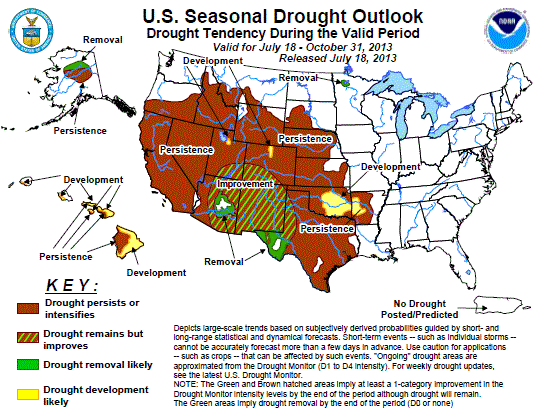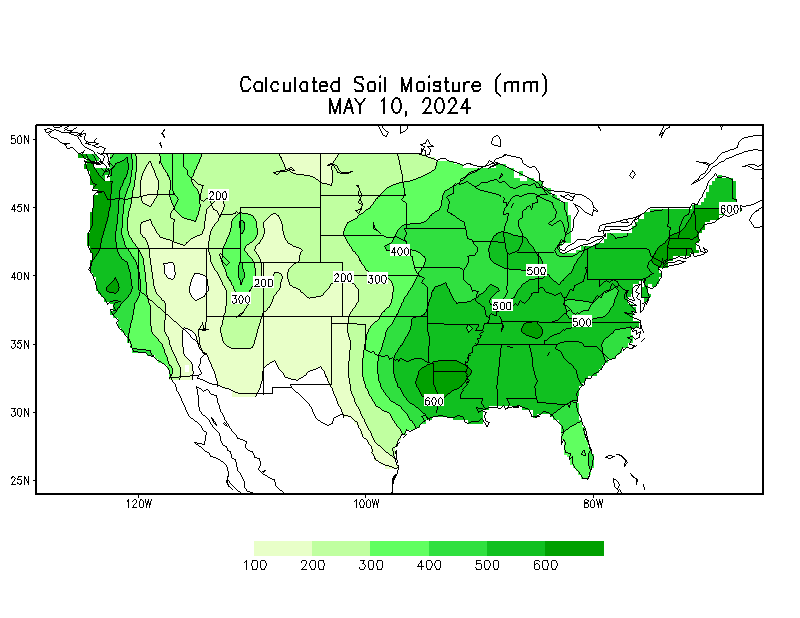Skip to comments.
More than 60 percent of U.S. in drought (Global Warming , We're Doomed, Film at 11 Alert!)
AP on Yahoo ^
| 7/29/06
| James McPherson -ap
Posted on 07/29/2006 7:14:09 PM PDT by NormsRevenge
STEELE, N.D. (AP) -- More than 60 percent of the United States now has abnormally dry or drought conditions, stretching from Georgia to Arizona and across the north through the Dakotas, Minnesota, Montana and Wisconsin, said Mark Svoboda, a climatologist for the National Drought Mitigation Center at the University of Nebraska at Lincoln.
An area stretching from south central North Dakota to central South Dakota is the most drought-stricken region in the nation, Svoboda said.
"It's the epicenter," he said. "It's just like a wasteland in north central South Dakota."
Conditions aren't much better a little farther north. Paul Smokov and his wife, Betty, raise several hundred cattle on their 1,750-acre ranch north of Steele, a town of about 760 people.
Fields of wheat, durum and barley in the Dakotas this dry summer will never end up as pasta, bread or beer. What is left of the stifled crops has been salvaged to feed livestock struggling on pastures where hot winds blow clouds of dirt from dried-out ponds.
Some ranchers have been forced to sell their entire herds, and others are either moving their cattle to greener pastures or buying more already-costly feed. Hundreds of acres of grasslands have been blackened by fires sparked by lightning or farm equipment.
"These 100-degree days for weeks steady have been burning everything up," said Steele Mayor Walter Johnson, who added that he'd prefer 2 feet of snow over this weather.
Farm ponds and other small bodies of water have dried out from the heat, leaving the residual alkali dust to be whipped up by the wind. The blowing, dirt-and-salt mixture is a phenomenon that hasn't been seen in south central North Dakota since the Dust Bowl of the 1930s, Johnson said.
North Dakota's all-time high temperature was set here in July 1936, at 121. Smokov, now 81, remembers that time and believes conditions this summer probably are worse.
"I could see this coming in May," Smokov said of the parched pastures and wilted crops. "That's the time the good Lord gives us our general rains. But we never got them this year."
Brad Rippey, a federal Agriculture Department meteorologist in Washington, said this year's drought is continuing one that started in the late 1990s. "The 1999 to 2006 drought ranks only behind the 1930s and the 1950s. It's the third-worst drought on record - period," Rippey said.
Svoboda was reluctant to say how bad the current drought might eventually be.
"We'll have to wait to see how it plays out - but it's definitely bad," he said. "And the drought seems to not be going anywhere soon."
Herman Schumacher, who owns Herreid Livestock Auction in north central South Dakota, said his company is handling more sales than ever because of the drought.
In May, June and July last year, his company sold 3,800 cattle. During the same months this year, more than 27,000 cattle have been sold, he said.
"I've been in the barn here for 25 years and I can't even compare this year to any other year," Schumacher said.
He said about 50 ranchers have run cows through his auction this year.
"Some of them just trimmed off their herds, but about a third of them were complete dispersions - they'll never be back," he said.
"This county is looking rough - these 100-degree days are just killing us," said Gwen Payne, a North Dakota State University extension agent in Kidder County, where Steele is located.
The Agriculture Department says North Dakota last year led the nation in production of 15 different commodity classes, including spring wheat, durum wheat, barley, oats, canola, pinto beans, dry edible peas, lentils, flaxseed, sunflower and honey.
North Dakota State University professor and researcher Larry Leistritz said it's too early to tell what effect this year's drought will have on commodity prices. Flour prices already have gone up and may rise more because of the effect of drought on wheat.
"There will be somewhat higher grain prices, no doubt about it," Leistritz said. "With livestock, the short-term effect may mean depressed meat prices, with a larger number of animals being sent to slaughter. But in the longer run it may prolong the period of relatively high meat prices."
Eventually, more than farmers could suffer.
"Agriculture is not only the biggest industry in the state, it's just about the only industry," Leistritz said. "Communities live or die with the fortunes of agriculture."
Susie White, who runs the Lone Steer motel and restaurant in Steele, along Interstate 94, said even out-of-state travelers notice the drought.
"Even I never paid attention to the crops around here. But I notice them now because they're not there," she said.
"We're all wondering how we're going to stay alive this winter if the farmers don't make any money this summer," she said.
---
On the Net:
National Drought Mitigation Center: http://drought.unl.edu/
TOPICS: Culture/Society; Government; News/Current Events
KEYWORDS: climatechange; doomed; drought; globalwarming; headforthehills; percent; theskyisfalling; weather; wereallgonnadie
Navigation: use the links below to view more comments.
first 1-20, 21-40, 41-43 next last
Shades of the 1930s is right..
My Dad used to tell me about farming in lake beds and such in Minnesota,, just part of a grand cycle ,, hang in there
To: NormsRevenge

Drought stricken corn withers in a field in Linton, N.D., Wednesday, July 26, 2006. Fields of wheat, durum and barley in the Dakotas this dry summer will never end up as pasta, bread or beer. What is left of the stifled crops has been salvaged to feed livestock struggling on pastures where hot winds blow clouds of dirt from dried-out ponds. (AP Photo/Will Kincaid)
2
posted on
07/29/2006 7:14:52 PM PDT
by
NormsRevenge
(Semper Fi ......Help the "Pendleton 8' and families -- http://www.freerepublic.com/~normsrevenge/)
To: NormsRevenge
We've gotten plenty of water here. I got caught in a damn near flash flood yesterday.
To: mainepatsfan
We've had a great summer here in southern Michigan.
4
posted on
07/29/2006 7:16:22 PM PDT
by
cripplecreek
(If stupidity got us into this mess, then why can't it get us out?)
To: NormsRevenge
Giggling...I think I'll go out and water my lawn for the third time today.
5
posted on
07/29/2006 7:16:24 PM PDT
by
Cindy
To: NormsRevenge

So what happened to all those cries of more hurricanes this year?!
...how quickly the news media forgets yesterdays claims of "The Sky is Falling!"
6
posted on
07/29/2006 7:16:47 PM PDT
by
Southack
(Media Bias means that Castro won't be punished for Cuban war crimes against Black Angolans in Africa)
To: mainepatsfan
we need a giant pipeline from wherever the water falls to where its needed , I reckun.. better get a hold of Haliburton, pronto.
7
posted on
07/29/2006 7:16:47 PM PDT
by
NormsRevenge
(Semper Fi ......Help the "Pendleton 8' and families -- http://www.freerepublic.com/~normsrevenge/)
To: NormsRevenge
Is that why watermelons are so expensive?
To: NormsRevenge
AP is on the doom & gloom thing again.
not a word about the solar warming period we have entered.
9
posted on
07/29/2006 7:18:22 PM PDT
by
GeronL
To: GeronL
ap flunked science.. that's why they are in gloom and doom.
I wonder if the solar cycle somehow transmit some energy that heats up the earth's core and loosens up the magma sacs a bit and waaa laaa,, we have more volcanoes popping off of late as a result, just a cyclical thing..
10
posted on
07/29/2006 7:21:35 PM PDT
by
NormsRevenge
(Semper Fi ......Help the "Pendleton 8' and families -- http://www.freerepublic.com/~normsrevenge/)
To: NormsRevenge
No, they are in doom and gloom because there is a guy with an R next to his name in the White House.
11
posted on
07/29/2006 7:24:26 PM PDT
by
GeronL
To: GeronL
mmmmm,, OK. I'll buy that too. lol
12
posted on
07/29/2006 7:26:15 PM PDT
by
NormsRevenge
(Semper Fi ......Help the "Pendleton 8' and families -- http://www.freerepublic.com/~normsrevenge/)
To: NormsRevenge
Here in Georgia we just had a massive rainstorm....I am not sure about any drought here. As for the rest of the country, when you consider that everything West of the 100th Parallel (basically Kansas and west) is a Desert it doesn't surprise me. Any place that has less than 10 inches of rain a year is a desert. Georgia is quite well here.
13
posted on
07/29/2006 7:34:25 PM PDT
by
Conan the Librarian
(The Best in Life is to crush my enemies, see them driven before me, and the Dewey Decimal System)
To: NormsRevenge
Shades of the 1930s is right..
Joe Bastardi (sp?) basically said this on FOX News in the spring.
Folks need to look at what the weather was like in the 1930 (my folks
talk about 1936 as hellish).
IIRC, even the Pacific Northwest dried up and burned a good bit.
You can't repeal the business cycle.
Or weather fluctuations.
14
posted on
07/29/2006 7:39:40 PM PDT
by
VOA
To: NormsRevenge
We've had a severe drought in NM for the last few years. That said, we're now in what appears to be an extended monsoon season. All the fire bans have been lifted across the entire state. It rains daily now. :o)
15
posted on
07/29/2006 7:40:33 PM PDT
by
NRA2BFree
(Only two defining forces have ever offered to die for you, Jesus Christ and the American G. I.)
To: NormsRevenge
16
posted on
07/29/2006 7:41:09 PM PDT
by
A message
(We who care, Can Not Fail)
To: NormsRevenge
The Dust Bowl is back! The economy stinks! It's Hoover-I mean BUSH's fault!/s;)
To: NormsRevenge
18
posted on
07/29/2006 7:44:02 PM PDT
by
NormsRevenge
(Semper Fi ......Help the "Pendleton 8' and families -- http://www.freerepublic.com/~normsrevenge/)
To: cripplecreek
We've had a great summer here in southern Michigan.Same here in the Blue Ridge region of north GA. The highest temperature so far at my house was an 86 last week, and most days have been in the low 80s.
Today we topped out at 76 with showers in the area, and the long range forecast is for morning lows in the 50s and highs in the 70s and low 80s for the first part of August. Not too bad for this far south, but if you go a little farther down to Atlanta it can be pretty uncomfortable this time of year.
19
posted on
07/29/2006 7:46:07 PM PDT
by
epow
(Proudly fighting on FR for truth , justice, and the last slice of leftover pizza since 1998)
To: epow
Today was pretty warm, about 90 degrees and the humidity was bad but it is summer. If anything it's been cooler than normal here.
20
posted on
07/29/2006 7:47:38 PM PDT
by
cripplecreek
(If stupidity got us into this mess, then why can't it get us out?)
Navigation: use the links below to view more comments.
first 1-20, 21-40, 41-43 next last
Disclaimer:
Opinions posted on Free Republic are those of the individual
posters and do not necessarily represent the opinion of Free Republic or its
management. All materials posted herein are protected by copyright law and the
exemption for fair use of copyrighted works.
FreeRepublic.com is powered by software copyright 2000-2008 John Robinson



